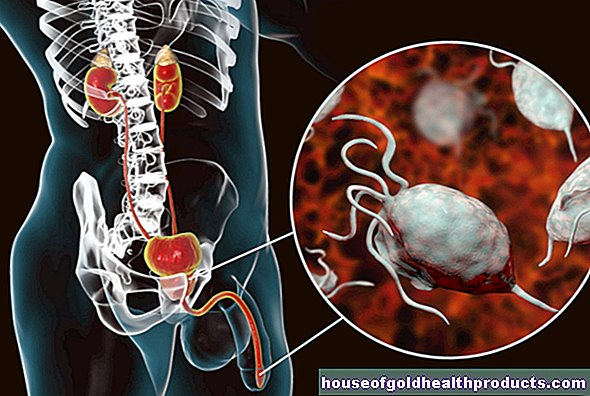Vitamin B6
Carola Felchner is a freelance writer in the medical department and a certified training and nutrition advisor. She worked for various specialist magazines and online portals before becoming a freelance journalist in 2015. Before starting her internship, she studied translation and interpreting in Kempten and Munich.
More about the experts All content is checked by medical journalists.Vitamin B6 is involved in central metabolic processes, for example in the conversion and incorporation of proteins as well as in the development and protection of nerve connections. It also supports the immune system. The body cannot produce the water-soluble vitamin B6 itself, which is why it has to be taken in through food. Find out how much vitamin B6 you need and what it's good for here.
What is Vitamin B6?
Vitamin B6, also called pyridoxine, is not a single substance, but a group of three compounds (pyridoxine, pyridoxal and pyridoxamine). The body cannot make it itself. However, a deficiency is very rare, as many plant and animal foods contain sufficient amounts of vitamin B6. Like all B vitamins, vitamin B6 is water-soluble. It is also sensitive to light and heat. Food containing B6 should therefore be prepared gently (e.g. gentle cooking instead of long cooking).
What are the tasks of vitamin B6 in the body?
Vitamin B6 takes on many important functions in the human body because it is an elementary component of some enzymes. The corresponding coenzymes PLP (pyridoxal phosphate) and PMP (pyridoxamine phosphate) are involved in almost 100 metabolic processes and are formed from B6.
Vitamin B6, for example, plays an important role in the amino acid metabolism, in which the body's own substances are produced from the building blocks of proteins (amino acids). PLP also helps in the production of numerous messenger substances of the nervous system (neurotransmitters) such as serotonin, dopamine or the allergy messenger substance histamine. But it is also involved in blood formation, especially in the production of hemoglobin (a pigment in red blood cells).
PLP (and thus vitamin B6) is also involved in lipid metabolism and the regulation of the immune system. The vitamin is also said to have an effect in the treatment of complaints such as pregnancy sickness, premenstrual syndrome (PMS) and carpal tunnel syndrome.
What is the daily requirement for vitamin B6?
According to the German Nutrition Society (DGE), the recommended daily amount of vitamin B6 for adolescents aged 15 and over and adults is 1.4 milligrams per day for women and 1.6 milligrams for men.
The exact requirement values vary depending on the individual energy consumption. The daily vitamin B6 requirement may be slightly increased during pregnancy and breastfeeding (see table). Those who take the estrogen (pill) may also have a higher need.
This is how much vitamin B6 you should consume according to the recommendation of the DGE:
|
age |
Vitamin B6 (in mg / day) | |
|
masculine |
Female | |
|
baby | ||
|
0 to under 4 months |
0,1 | |
|
4 to less than 12 months
|
0,3 | |
|
children | ||
|
1 to under 4 years |
0,6 | |
|
4 to under 7 years |
0,5 | |
|
7 to under 10 years |
0,7 | |
|
10 to under 13 years |
1,2 | |
|
13 to under 15 years |
1,5 |
1,4 |
|
Teenagers and adults | ||
|
15 to under 19 years |
1,6 |
1,2 |
|
19 to under 25 years |
1,6 |
1,4 |
|
25 to under 51 years |
1,6 |
1,4 |
|
51 to under 65 years |
1,6 |
1,4 |
|
65 years and older |
1,6 |
1,4 |
|
Pregnant women | ||
|
in the 1st trimester |
1,5 | |
|
in the 2nd / 3rd Trimester
|
1,8 | |
|
Breastfeeding |
1,6 | |
Vitamin B6: foods with a high content
Read more about foods rich in vitamin B6 in the article Foods high in vitamin B6.
How does a vitamin B6 deficiency manifest itself?
You can read everything you need to know about how a vitamin B6 deficiency develops, how it manifests itself and what consequences it has in the article Vitamin B6 deficiency.
How does a vitamin B6 excess manifest itself?
If pyridoxine is taken in high doses over a long period of time, it can lead to a vitamin B6 overdose. If you ingest more than 500 milligrams a day, one speaks of chronic overdose. However, this amount can only be absorbed through food supplements, not through food.
A long-term vitamin B6 overdose can cause nerve damage, which manifests itself in the form of fatigue, lethargy, paralysis, temperature sensation disorders, numbness in the extremities or skin inflammation (dermatitis).
In one study, however, unusually high vitamin B doses also caused the brains of people with mild cognitive impairment (LKB) to shrink significantly more slowly and slowed down the development of dementia lastingly.
Tags: sports fitness Menstruation Baby Child





























